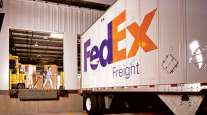Most FedEx Rates Will Rise by 4.9% on Jan. 1

FedEx Corp. announced rate increases for its three major divisions that will take effect Jan. 1.
Most of the increases were for 4.9% over the current rates. The price hikes are general tariff increases for occasional shippers and are not binding on high-volume contract shippers.
FedEx said Sept. 18 that the 4.9% increases are for the corporation’s Express, Ground and Freight divisions, including the Home Delivery and SmartPost services within Ground.
FedEx ranks No. 2 on the Transport Topics Top 100 list of for-hire carriers in North America behind its main rival UPS Inc.
The major exception is the company’s One Rate plan, which will increase by 3.5% at the start of 2018. One Rate is a flat-rate option available for domestic Express shipments and packaging.
RELATED: FedEx quarterly profits decline
As for other increases, the company also said that for Jan. 22:
• A third-party billing surcharge will apply to Express and Ground shipments that are billed to a third party.
• Applicable criteria and pricing for packages that require additional handling, are oversize or are unauthorized, will change.
• SmartPost will apply dimensional weight pricing, and the nonmachinable surcharge will change.
• The less-than-truckload Freight unit will implement an overlength surcharge of $85 per shipment. The surcharge will be applied to shipments with dimensions of 8 to 12 feet.

Baris Tasdelen, senior analyst for supply chain consulting firm enVista Corp., said the increase is consistent with recent actions by FedEx and UPS.
In general, “3.9% or 4.9% per year has been the trend,” Tasdelen said.
With the boom in e-commerce shipments, Tasdelen said the two big parcel carriers are enjoying a sellers market for their services. Shippers have some options but not a lot, he said.
“When DHL got out of the domestic market, there was more pressure on pricing before then,” he said.
The U.S. Postal Service still does parcel work, Tasdelen said, but often teams with FedEx and UPS to provide last-mile delivery for the private sector companies. There also are regional parcel carriers, but their respective service areas are ultimately limited.
Looking at individual pricing changes is not enough, Tasdelen said. It is critical for shippers to understand how they may be layered.
As an example, he noted that SmartPost is getting a basic price increase plus a switch to dimensional weight pricing and a third-party fee. All of these could hit the same shipment.
“It’s a compounding increase,” he said.
Before the new year arrives, holiday shipping will occur in November and December. Tasdelen said a holiday surcharge probably is not the most critical issue — UPS has one, FedEx does not.
More important he said, are the incentives for ordinary, moderate-size parcels.
“They don’t want large packages that clog up their systems,” Tasdelen said.
FedEx stressed fees for oversize and unauthorized parcels or those requiring extra handling, and UPS has similar concerns, he said.




